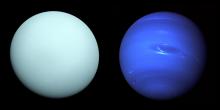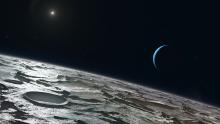Listen to today's episode of StarDate on the web the same day it airs in high-quality streaming audio without any extra ads or announcements. Choose a $8 one-month pass, or listen every day for a year for just $30.
You are here
Neptune at Opposition
One of the giants of the outer solar system is at its best this week. Neptune lines up opposite the Sun in our sky. From that position, it rises at sunset and is in the sky all night. And it shines at its brightest. It’s the Sun’s most remote major planet, though — about 2.7 billion miles away — so you need good binoculars or a telescope to see it.
Neptune is the fourth-largest planet in the solar system — roughly four times the diameter of Earth. But it’s the third most-massive planet, just eking past Uranus.
Neptune and Uranus are “ice giants.” Neptune has a small, dense core that’s roughly as massive as Earth. And it has a thick atmosphere of hydrogen, helium, and a dab of methane, which contributes to its bright blue color.
Between the core and atmosphere are layers of compounds that are classified as “ices” — mainly water, methane, and ammonia. The ices aren’t cold, though. Neptune’s gravity squeezes them tightly, heating them to hundreds or thousands of degrees. The great pressure deep within Neptune keeps these layers from boiling away. In fact, the layer directly below the atmosphere could be a deep ocean of super-hot water.
Neptune’s atmosphere has some of the strongest winds in the solar system, and we’ll have more about that tomorrow.
The giant planet is in Pisces, the fishes. As darkness falls, Neptune stands below the pentagon of stars that outlines the head of one of the fish.
Script by Damond Benningfield





